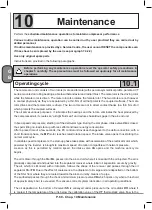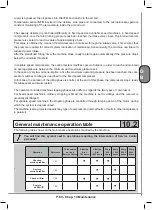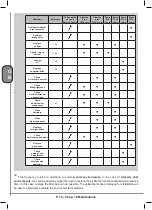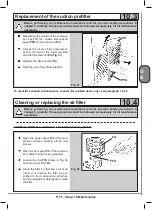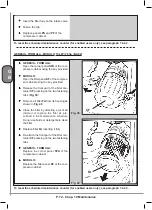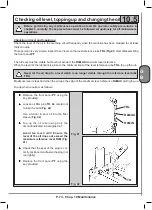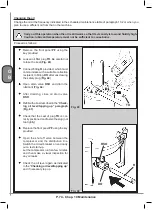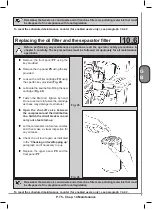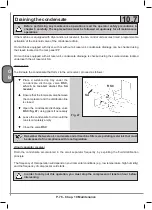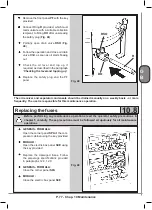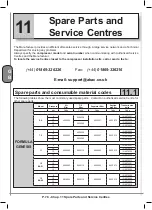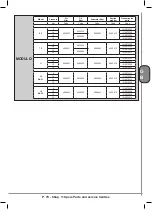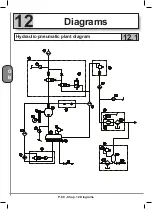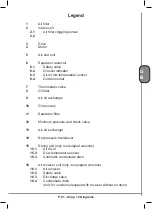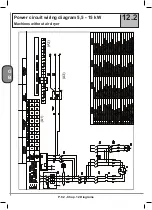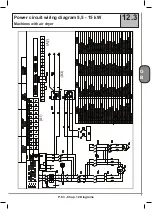
P. 68 - Chap. 10 Maintenance
10
Maintenance
G
B
Perform the
scheduled maintenance operations to maintain compressor performance
.
Various routine maintenance operation can be carried out by user provided they are carried out by
skilled personnel.
If routine maintenance is provided by a Service Centre, the user cannot RESET the components even
if these have been replaced by the user (see paragraph 7.4.2.2)
Use only original spare parts
Instructions are provided in the following paragraphs.
Before performing any maintenance operations read the operator safety precautions in
chapter 5 carefully. These precautions must be followed scrupulously for all maintenance
operations
Operating cycle
10.1
The compressor unit consists of two rotors (male and female) with special asymmetrical profile, patented VT
series, mounted on rolling bearings, able to withstand axial and radial thrust. The male rotor is the driving rotor
while the female rotor is driven. The male rotor also rotates the female rotor. The two rotors are not however
in contact physically as they are separated by a thin film of oil that protects the coupled surfaces. The male
rotor drives and the female rotor is driven. The two rotors are not in direct contact thanks to a thin film of oil
which protects the coupled surfaces.
The oil serves various purposes. It lubricates the bearings and the rotors, eliminates the heat produced by
the compressed air, it creates an “airtight fluid seal” and reduces hazardous gaps in the air-end unit.
In fixed speed compressors, starting is of the delta-star type. During the star phase, intake valve
VA
is closed,
thus permitting no-load start-up with less effort and lower energy consumption.
After a preset time of a few seconds, the PC control unit invokes changeover to the delta connection; with a
short transient phase, the
MP
motor reaches rated rotation speed. The intake valve opens thus starting the
normal work cycle.
In variable speed compressors, the start-up phase takes place with acceleration of the electrical motor which,
powered by the inverter, is brought to maximum speed of rotation compatible with network pressure.
As soon as this is permitted by rotation speed, the intake valve
VA
opens and the machine work cycle
begins.
The air is drawn through the filter
FA
, passes into the air-end unit where it is mixed with the oil injected. The air is
gradually compressed and pushed into the separator receiver where initial oil separation occurs by gravity.
The air, which is still mixed with oil droplets, follows the shape of the receiver and passes through the oil
separator filter
FD
. Due to the effect of coalescence, the droplets of oil merge and are deposited on the bottom
of the filter from where they are routed towards the air-end unit by means of a pipe.
The purified air passes through the check and minimum pressure valve
VR
which opens only when a threshold
of approximately 4 bar is exceeded. This ensures correct system lubrication in all operating conditions.
The oil deposited on the bottom of receiver
SS
is conveyed under pressure to the oil radiator
RO
where it
is cooled. If the temperature of the oil is below the calibration value of the
VT
thermostatic valve, flow to the
Summary of Contents for FORMULA Series
Page 1: ...GENESIS FORMULA MODULO 5 5 15 kW USE AND MAINTENANCE HANDBOOK GB ...
Page 2: ......
Page 82: ...P 80 Chap 12 Diagrams G B 12 Diagrams Hydraulic pneumatic plant diagram 12 1 ...
Page 85: ...P 83 Chap 12 Diagrams G B Power circuit wiring diagram 5 5 15 kW Machines with air dryer 12 3 ...
Page 86: ...P 84 Chap 12 Diagrams G B Power circuit wiring diagram 11 kW Machines with inverter 12 4 ...
Page 89: ...P 87 Chap 12 Diagrams G B Auxiliary circuit wiring diagram 11 kW Machines with inverter 12 7 ...















